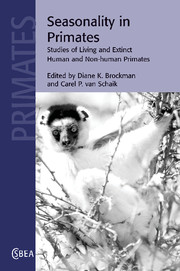Book contents
- Frontmatter
- Contents
- List of contributors
- Preface
- Part I Introduction
- Part II Seasonal habitats
- Part III Seasonality and behavioral ecology
- Part IV Seasonality, reproduction, and social organization
- 10 Seasonality and reproductive function
- 11 Seasonality of primate births in relation to climate
- 12 Energetic responses to food availability in the great apes: implications for hominin evolution
- 13 Human birth seasonality
- 14 Seasonality, social organization, and sexual dimorphism in primates
- Part V Seasonality and community ecology
- Part VI Seasonality and human evolution
- Index
- References
14 - Seasonality, social organization, and sexual dimorphism in primates
Published online by Cambridge University Press: 10 August 2009
- Frontmatter
- Contents
- List of contributors
- Preface
- Part I Introduction
- Part II Seasonal habitats
- Part III Seasonality and behavioral ecology
- Part IV Seasonality, reproduction, and social organization
- 10 Seasonality and reproductive function
- 11 Seasonality of primate births in relation to climate
- 12 Energetic responses to food availability in the great apes: implications for hominin evolution
- 13 Human birth seasonality
- 14 Seasonality, social organization, and sexual dimorphism in primates
- Part V Seasonality and community ecology
- Part VI Seasonality and human evolution
- Index
- References
Summary
Introduction
Primates live in habitats in which food abundance and other resources fluctuate over time, usually on a seasonal basis, and space. This variation affects the lives of primates in many ways, from behavioral ecology to reproduction (see Chapters 3 and 11). In this chapter, we explore how environmental and behavioral seasonality affect sexual dimorphism.
Sexual dimorphism in body and canine size among primates generally is viewed as primarily a consequence of sexual selection operating through the mechanism of male–male competition for mates (Leutenegger & Kelly 1977; Clutton-Brock et al. 1977; Kay et al. 1988; Plavcan & van Schaik 1992, 1997; Ford 1994; Lindenfors & Tullberg 1998) and modified by female choice for male traits (Plavcan 2004). Sexual dimorphism can be affected by environmental seasonality in two independent ways (see Fig. 14.1): first through the indirect impact of seasonality on the potential for mate monopolization (Mitani et al. 1996a; Nunn 1999; Pereira et al. 2000), and second through the direct impact of seasonality on male and female body size (Albrecht 1978; Turner et al. 1997). In the first case, phenological or climatic seasonality brings about the simultaneous presence of multiple cycling females due to reproductive seasonality and also may favor larger female group size. These effects in turn should affect the number of males present in a group, and patterns of male–male competition and resulting reproductive skew – in other words, several aspects of social organization and the mating system, all of which are tied to sexual dimorphism.
- Type
- Chapter
- Information
- Seasonality in PrimatesStudies of Living and Extinct Human and Non-Human Primates, pp. 401 - 442Publisher: Cambridge University PressPrint publication year: 2005
References
- 23
- Cited by



